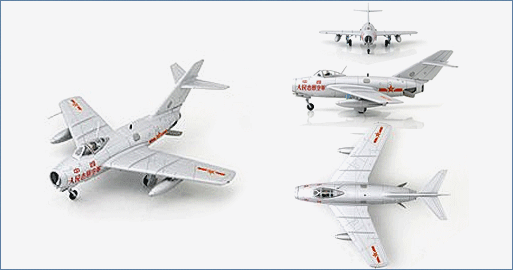Air Power Series>1:72 die-cast display model>MIG-15>HA2419
MIG-15bis China Air Force (PLAAF), Chinese Aviation Museum

General Background
The MiG-15 (NATO name Fagot) was designed from information and technology gathered from captured WWII Germans. The main features of the Mig-15 were its simplicity and swept wings. The MiG-15bis was an improved single-seat fighter with better cannon, fuel capacity, avionics and a Klimov turbojet engine developed using an unlicensed Rolls-Royce Nene engine. All this was put in a strengthened airframe. The Allies were completely surprised when the Mig-15 arrived in Korea and quickly brought about the development of the F-86 Sabre.
The Aircraft
Between 1950 and 1951 China’s PLAAF received 654 MiG-15 Fagot (bundle of wood)
from the Soviet Union. Between 1952 and 1955 they imported 1,460 MiG-15bis along
with 357 MiG-15UTI trainers between 1951 and 1958. In 1980 the last MiG-15 Fagot
was retired followed by the MiG-15bis in 1986. Some of these retired aircraft were
converted to tandem trainers and the last MiG-15UTI was withdrawn from service in
1986. This particular aircraft can be seen at the China Aviation Museum Datangshan,
just outside Beijing.
Specifications :
| Country of origin: | Russia |
| Manufacturer: | Mikoyan-Gurevich |
| Role: | fighter/interceptor |
| Crew: | 1 X pilot |
| Performance | |
| Engine: | 1 X 5,952 pound thrust Klimov VK-1 turbojet |
| Maximum Speed at Sea Level: | 668mph (1,075km/hr) |
| Ceiling: | 50,855ft. |
| Range: | 1,156miles (1860km) |
| Weight | |
| Emptyt: | 8,115lbs. (3,681kg) |
| Max Takeoff: | 13,327lbs. (6,045kg) |
| Dimensions | |
| Wing Span: | 33ft. 0.75in. (10,08m) |
| Length: | 35ft. 7.5in. (10,86m) |
| Height: | 12ft. 1.75in. (3,70m) |
| Armament: | 1 X 37-mm N-37 cannon |
| 2 X 23-mm NS-23 or NR-23 cannon | |
| Up to 1,100 pounds of mixed stores on under-wing hard-points |

